MITSUBISHI L200 2015 Owner's Manual (in English)
Manufacturer: MITSUBISHI, Model Year: 2015, Model line: L200, Model: MITSUBISHI L200 2015Pages: 418, PDF Size: 25.8 MB
Page 181 of 418
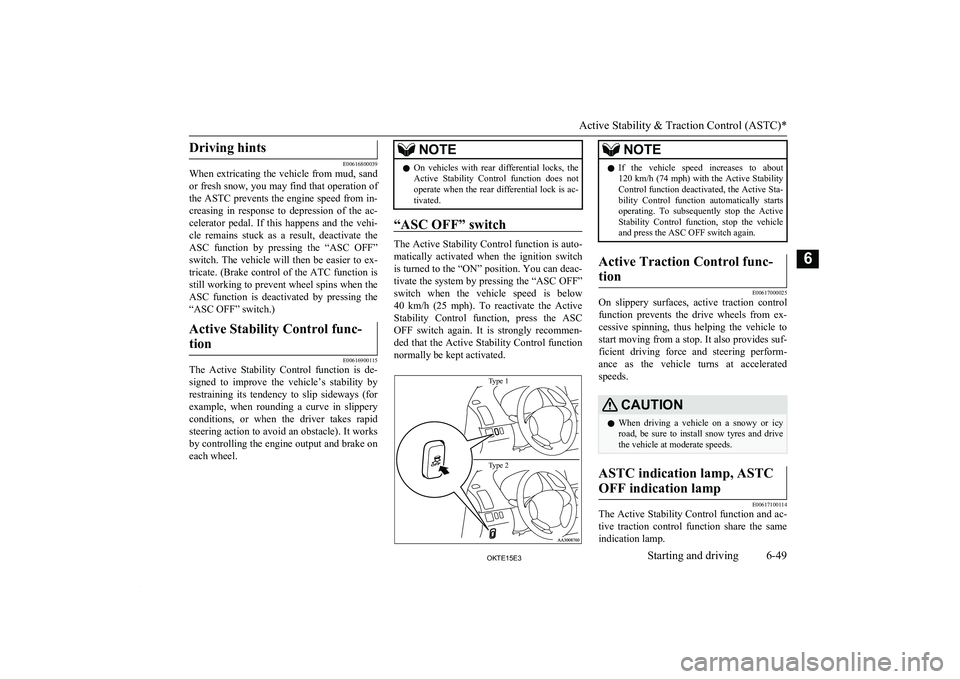
Driving hints
E00616800039
When extricating the vehicle from mud, sand
or fresh snow, you may find that operation of
the ASTC prevents the engine speed from in-
creasing in response to depression of the ac- celerator pedal. If this happens and the vehi-cle remains stuck as a result, deactivate the
ASC function by pressing the “ASC OFF”
switch. The vehicle will then be easier to ex- tricate. (Brake control of the ATC function isstill working to prevent wheel spins when the
ASC function is deactivated by pressing the “ASC OFF” switch.)
Active Stability Control func-
tion
E00616900115
The Active Stability Control function is de- signed to improve the vehicle’s stability byrestraining its tendency to slip sideways (for
example, when rounding a curve in slippery conditions, or when the driver takes rapid
steering action to avoid an obstacle). It works
by controlling the engine output and brake on each wheel.
NOTEl On vehicles with rear differential locks, the
Active Stability Control function does notoperate when the rear differential lock is ac-
tivated.
“ASC OFF” switch
The Active Stability Control function is auto-
matically activated when the ignition switch
is turned to the “ON” position. You can deac- tivate the system by pressing the “ASC OFF”
switch when the vehicle speed is below 40 km/h (25 mph). To reactivate the Active
Stability Control function, press the ASC OFF switch again. It is strongly recommen-
ded that the Active Stability Control function
normally be kept activated.
Type 1Type 2
NOTEl If the vehicle speed increases to about
120 km/h (74 mph) with the Active Stability Control function deactivated, the Active Sta-bility Control function automatically starts operating. To subsequently stop the Active
Stability Control function, stop the vehicle
and press the ASC OFF switch again.Active Traction Control func-
tion
E00617000025
On slippery surfaces, active traction control function prevents the drive wheels from ex- cessive spinning, thus helping the vehicle to
start moving from a stop. It also provides suf-
ficient driving force and steering perform- ance as the vehicle turns at accelerated
speeds.
CAUTIONl When driving a vehicle on a snowy or icy
road, be sure to install snow tyres and drive the vehicle at moderate speeds.ASTC indication lamp, ASTC
OFF indication lamp
E00617100114
The Active Stability Control function and ac-
tive traction control function share the same indication lamp.
Active Stability & Traction Control (ASTC)*
6-49OKTE15E3Starting and driving6
Page 182 of 418
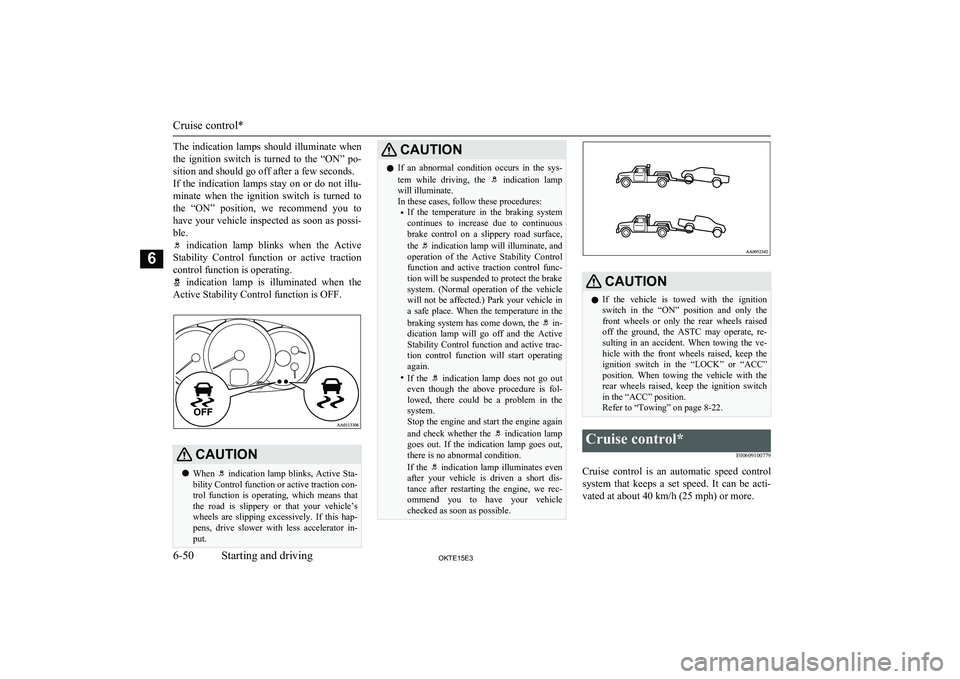
The indication lamps should illuminate when
the ignition switch is turned to the “ON” po- sition and should go off after a few seconds.
If the indication lamps stay on or do not illu- minate when the ignition switch is turned to
the “ON” position, we recommend you to have your vehicle inspected as soon as possi-ble.
indication lamp blinks when the Active
Stability Control function or active traction
control function is operating.
indication lamp is illuminated when the
Active Stability Control function is OFF.
CAUTIONl When indication lamp blinks, Active Sta-
bility Control function or active traction con- trol function is operating, which means that
the road is slippery or that your vehicle’s wheels are slipping excessively. If this hap-
pens, drive slower with less accelerator in-
put.CAUTIONl If an abnormal condition occurs in the sys-
tem while driving, the indication lamp
will illuminate.
In these cases, follow these procedures:
• If the temperature in the braking system
continues to increase due to continuous brake control on a slippery road surface,
the
indication lamp will illuminate, and
operation of the Active Stability Control function and active traction control func-
tion will be suspended to protect the brake
system. (Normal operation of the vehicle will not be affected.) Park your vehicle in
a safe place. When the temperature in the
braking system has come down, the
in-
dication lamp will go off and the Active
Stability Control function and active trac- tion control function will start operating again.
• If the
indication lamp does not go out
even though the above procedure is fol-
lowed, there could be a problem in the system.
Stop the engine and start the engine again
and check whether the
indication lamp
goes out. If the indication lamp goes out, there is no abnormal condition.
If the
indication lamp illuminates even
after your vehicle is driven a short dis-
tance after restarting the engine, we rec-
ommend you to have your vehicle checked as soon as possible.
CAUTIONl If the vehicle is towed with the ignition
switch in the “ON” position and only the
front wheels or only the rear wheels raised off the ground, the ASTC may operate, re-
sulting in an accident. When towing the ve- hicle with the front wheels raised, keep the
ignition switch in the “LOCK” or “ACC” position. When towing the vehicle with the
rear wheels raised, keep the ignition switch in the “ACC” position.
Refer to “Towing” on page 8-22.Cruise control*
E00609100779
Cruise control is an automatic speed controlsystem that keeps a set speed. It can be acti-vated at about 40 km/h (25 mph) or more.
Cruise control*
6-50OKTE15E3Starting and driving6
Page 183 of 418
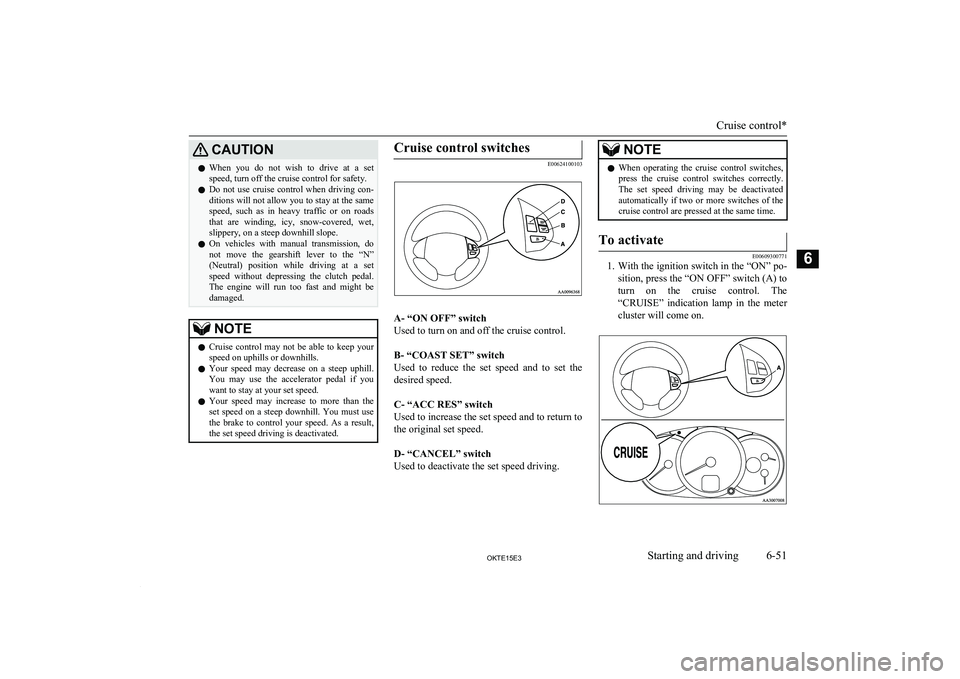
CAUTIONlWhen you do not wish to drive at a set
speed, turn off the cruise control for safety.
l Do not use cruise control when driving con-
ditions will not allow you to stay at the same
speed, such as in heavy traffic or on roads that are winding, icy, snow-covered, wet,
slippery, on a steep downhill slope.
l On vehicles with manual transmission, do
not move the gearshift lever to the “N” (Neutral) position while driving at a setspeed without depressing the clutch pedal.The engine will run too fast and might be damaged.NOTEl Cruise control may not be able to keep your
speed on uphills or downhills.
l Your speed may decrease on a steep uphill.
You may use the accelerator pedal if you
want to stay at your set speed.
l Your speed may increase to more than the
set speed on a steep downhill. You must use the brake to control your speed. As a result, the set speed driving is deactivated.Cruise control switches
E00624100103
A- “ON OFF” switch
Used to turn on and off the cruise control.
B- “COAST SET” switch
Used to reduce the set speed and to set the
desired speed.
C- “ACC RES” switch
Used to increase the set speed and to return to
the original set speed.
D- “CANCEL” switch
Used to deactivate the set speed driving.
NOTEl When operating the cruise control switches,
press the cruise control switches correctly.
The set speed driving may be deactivated automatically if two or more switches of the
cruise control are pressed at the same time.To activate
E00609300771
1. With the ignition switch in the “ON” po-
sition, press the “ON OFF” switch (A) to turn on the cruise control. The
“CRUISE” indication lamp in the meter cluster will come on.
Cruise control*
6-51OKTE15E3Starting and driving6
Page 184 of 418

NOTElIf the cruise control is on when the ignition
switch is turned to the “LOCK” or “ACC” position, cruise control will be on automati- cally the next time you start the engine.
The “CRUISE” indication lamp will also be
on.
l If the battery voltage is insufficient, the
memory data for the cruise control may be erased.
As a result, the “CRUISE” indication lamp may not come on when you restart the en-
gine.
If this happens, press the “ON OFF” switch once again to turn on the cruise control.
2. Accelerate or decelerate to your desired
speed, then press and release the “COAST SET” switch (B) when the
“CRUISE” indication lamp is illumina- ted. The vehicle will then maintain the
desired speed.
NOTEl When you release the “COAST SET”
switch, the vehicle speed will be set.To increase the set speed
E00609400570
There are 2 ways to increase the set speed.
“ACC RES” switch
Press and hold the “ACC RES” switch (C)while driving at the set speed, and your speed
will then gradually increase.
When you reach your desired speed, release
the switch. Your new cruising speed is now set.
To increase your speed in small amounts,
press the “ACC RES” switch for less than about 1 second and release it. Each time youpress the “ACC RES” switch, your vehicle
will go about 1.6 km/h (1 mph) faster.
Accelerator pedal
While driving at the set speed, use the accel-
erator pedal to reach your desired speed and
then press the “COAST SET” switch (B) and release the switch momentarily to set a new
desired cruising speed.
To decrease the set speed
E00609500500
There are 2 ways to decrease the set speed.
“COAST SET” switch
Press and hold the “COAST SET” switch (B)
while driving at the set speed, and your speed will slow down gradually.
Cruise control*
6-52OKTE15E3Starting and driving6
Page 185 of 418
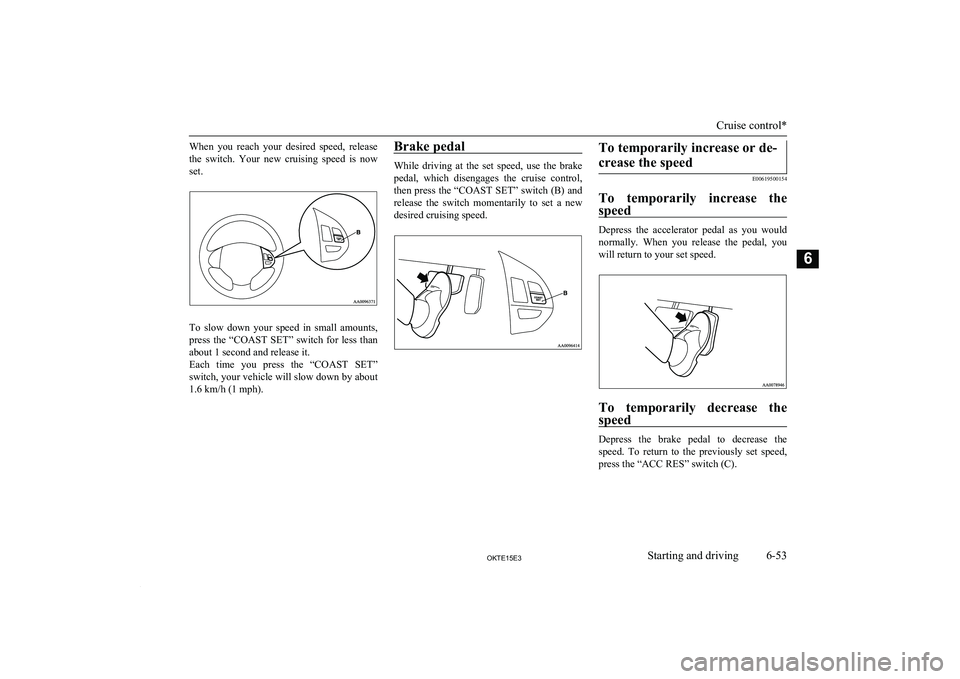
When you reach your desired speed, release
the switch. Your new cruising speed is now set.
To slow down your speed in small amounts,
press the “COAST SET” switch for less than about 1 second and release it.
Each time you press the “COAST SET” switch, your vehicle will slow down by about
1.6 km/h (1 mph).
Brake pedal
While driving at the set speed, use the brake
pedal, which disengages the cruise control,
then press the “COAST SET” switch (B) and
release the switch momentarily to set a new desired cruising speed.
To temporarily increase or de-
crease the speed
E00619500154
To temporarily increase the speed
Depress the accelerator pedal as you would
normally. When you release the pedal, you will return to your set speed.
To temporarily decrease the
speed
Depress the brake pedal to decrease the speed. To return to the previously set speed,
press the “ACC RES” switch (C).
Cruise control*
6-53OKTE15E3Starting and driving6
Page 186 of 418
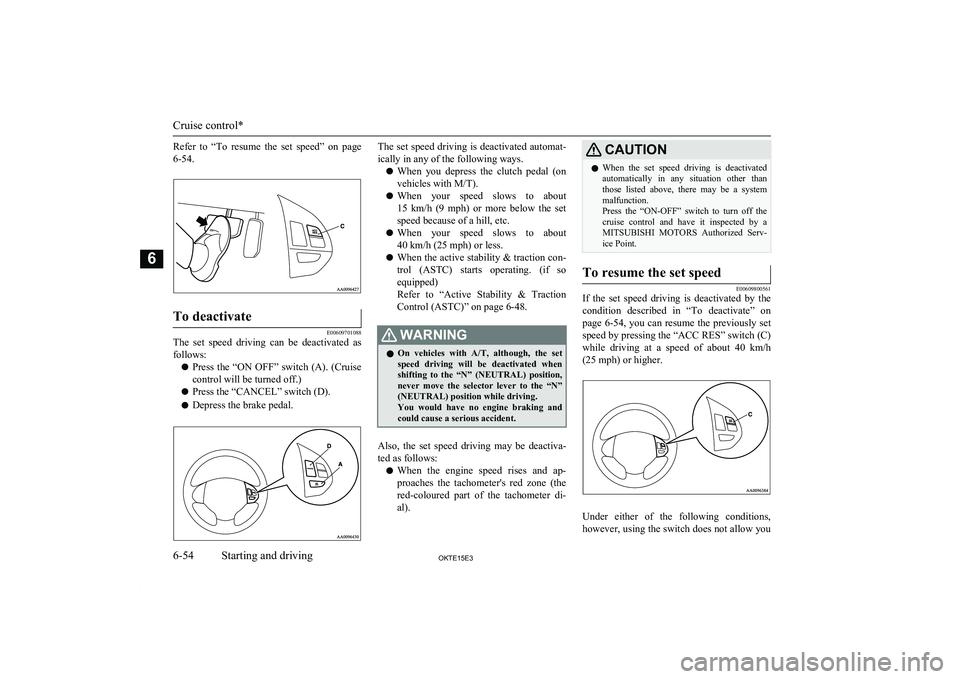
Refer to “To resume the set speed” on page
6-54.To deactivate
E00609701088
The set speed driving can be deactivated as follows:
l Press the “ON OFF” switch (A). (Cruise
control will be turned off.)
l Press the “CANCEL” switch (D).
l Depress the brake pedal.
The set speed driving is deactivated automat-
ically in any of the following ways.
l When you depress the clutch pedal (on
vehicles with M/T).
l When your speed slows to about
15 km/h (9 mph) or more below the set
speed because of a hill, etc.
l When your speed slows to about
40 km/h (25 mph) or less.
l When the active stability & traction con-
trol (ASTC) starts operating. (if so
equipped)
Refer to “Active Stability & Traction
Control (ASTC)” on page 6-48.WARNINGl On vehicles with
A/T, although, the set
speed driving will be deactivated when
shifting to the “N” (NEUTRAL) position, never move the selector lever to the “N”
(NEUTRAL) position while driving.
You would have no engine braking and
could cause a serious accident.
Also, the set speed driving may be deactiva-
ted as follows:
l When the engine speed rises and ap-
proaches the tachometer's red zone (the red-coloured part of the tachometer di- al).
CAUTIONl When the set speed driving is deactivated
automatically in any situation other thanthose listed above, there may be a system
malfunction.
Press the “ON-OFF” switch to turn off the cruise control and have it inspected by a MITSUBISHI MOTORS Authorized Serv-
ice Point.To resume the set speed
E00609800561
If the set speed driving is deactivated by the
condition described in “To deactivate” on
page 6-54, you can resume the previously set
speed by pressing the “ACC RES” switch (C)
while driving at a speed of about 40 km/h (25 mph) or higher.
Under either of the following conditions,however, using the switch does not allow you
Cruise control*
6-54OKTE15E3Starting and driving6
Page 187 of 418
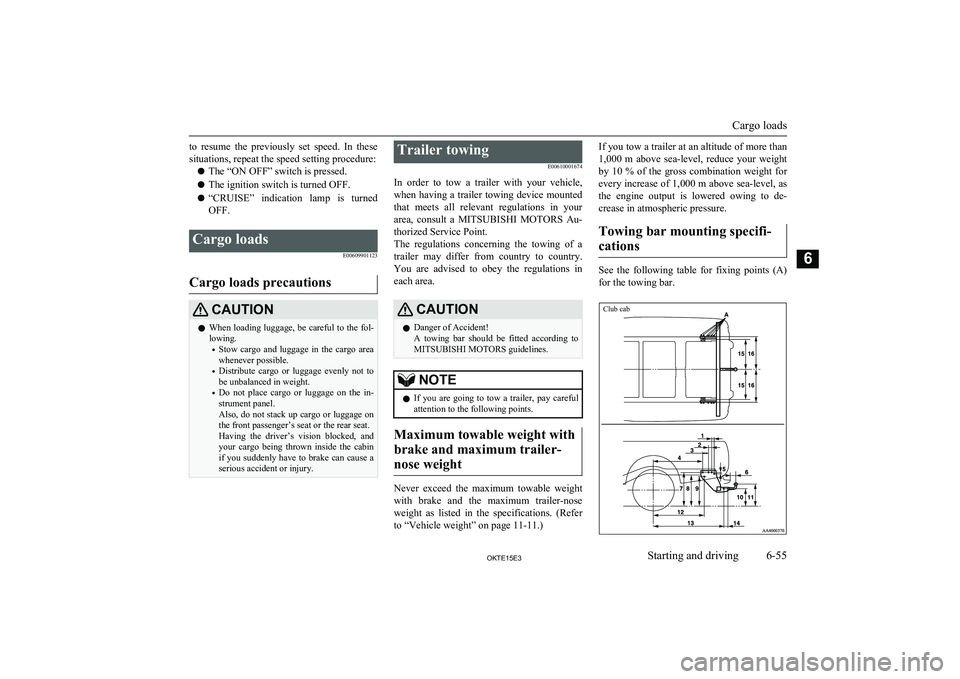
to resume the previously set speed. In thesesituations, repeat the speed setting procedure:
l The “ON OFF” switch is pressed.
l The ignition switch is turned OFF.
l “CRUISE” indication lamp is turned
OFF.Cargo loads
E00609901123
Cargo loads precautions
CAUTIONlWhen loading luggage, be careful to the fol-
lowing.
• Stow cargo and luggage in the cargo area
whenever possible.
• Distribute cargo or luggage evenly not to
be unbalanced in weight.
• Do not place cargo or luggage on the in-
strument panel.
Also, do not stack up cargo or luggage on the front passenger’s seat or the rear seat.
Having the driver’s vision blocked, and
your cargo being thrown inside the cabin if you suddenly have to brake can cause a
serious accident or injury.Trailer towing
E00610001674
In order to tow a trailer with your vehicle,
when having a trailer towing device mounted that meets all relevant regulations in your
area, consult a MITSUBISHI MOTORS Au-
thorized Service Point.
The regulations concerning the towing of a
trailer may differ from country to country. You are advised to obey the regulations in
each area.CAUTIONl Danger of Accident!
A towing bar should be fitted according to MITSUBISHI MOTORS guidelines.NOTEl If you are going to tow a trailer, pay careful
attention to the following points.
Maximum towable weight with
brake and maximum trailer- nose weight
Never exceed the maximum towable weight
with brake and the maximum trailer-nose weight as listed in the specifications. (Referto “Vehicle weight” on page 11-11.)
If you tow a trailer at an altitude of more than
1,000 m above sea-level, reduce your weight
by 10 % of the gross combination weight for
every increase of 1,000 m above sea-level, as the engine output is lowered owing to de-
crease in atmospheric pressure.
Towing bar mounting specifi-cations
See the following table for fixing points (A) for the towing bar.
Club cab
Cargo loads
6-55OKTE15E3Starting and driving6
Page 188 of 418
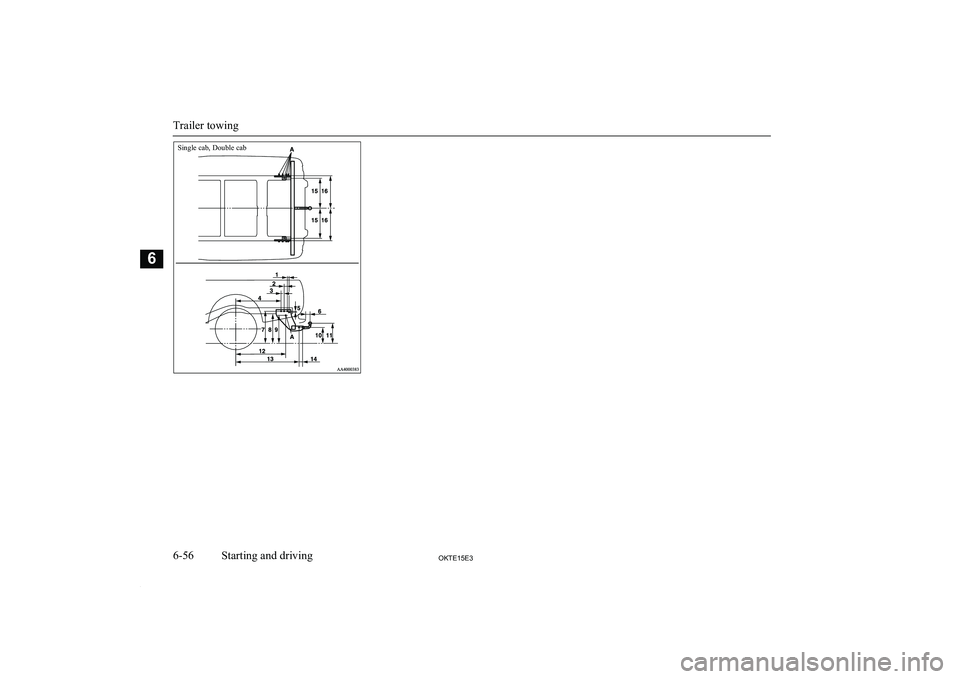
Single cab, Double cab
Trailer towing
6-56OKTE15E3Starting and driving6
Page 189 of 418
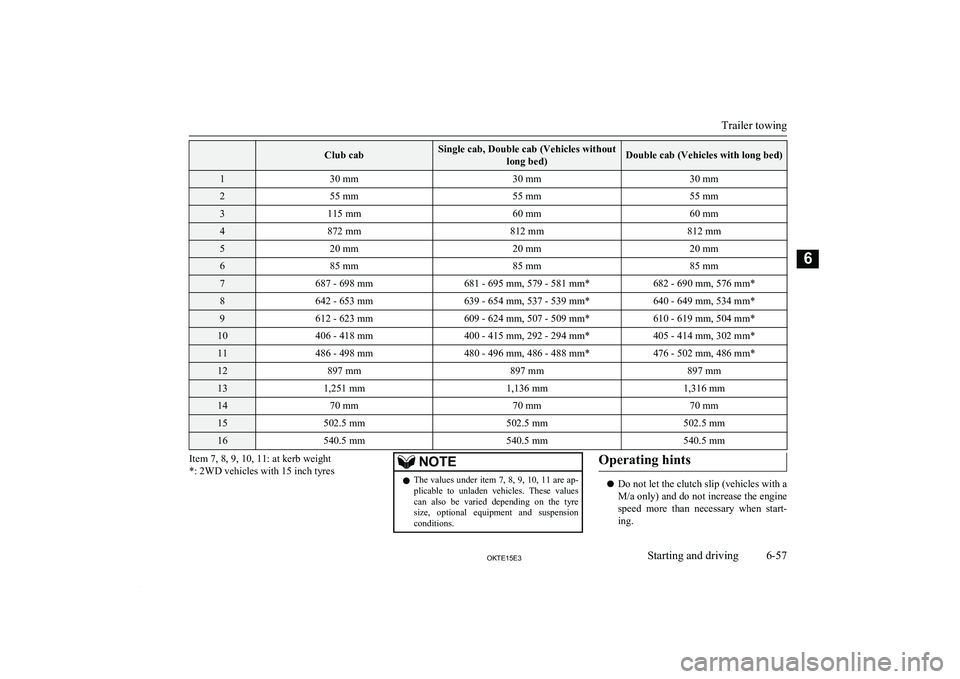
Club cabSingle cab, Double cab (Vehicles withoutlong bed)Double cab (Vehicles with long bed)130 mm30 mm30 mm255 mm55 mm55 mm3115 mm60 mm60 mm4872 mm812 mm812 mm520 mm20 mm20 mm685 mm85 mm85 mm7687 - 698 mm681 - 695 mm, 579 - 581 mm*682 - 690 mm, 576 mm*8642 - 653 mm639 - 654 mm, 537 - 539 mm*640 - 649 mm, 534 mm*9612 - 623 mm609 - 624 mm, 507 - 509 mm*610 - 619 mm, 504 mm*10406 - 418 mm400 - 415 mm, 292 - 294 mm*405 - 414 mm, 302 mm*11486 - 498 mm480 - 496 mm, 486 - 488 mm*476 - 502 mm, 486 mm*12897 mm897 mm897 mm131,251 mm1,136 mm1,316 mm1470 mm70 mm70 mm15502.5 mm502.5 mm502.5 mm16540.5 mm540.5 mm540.5 mmItem 7, 8, 9, 10, 11: at kerb weight
*: 2WD vehicles with 15 inch tyresNOTEl The values under item 7, 8, 9, 10, 11 are ap-
plicable to unladen vehicles. These values
can also be varied depending on the tyre size, optional equipment and suspension
conditions.Operating hints
l Do not let the clutch slip (vehicles with a
M/a only) and do not increase the engine
speed more than necessary when start-
ing.Trailer towing
6-57OKTE15E3Starting and driving6
Page 190 of 418
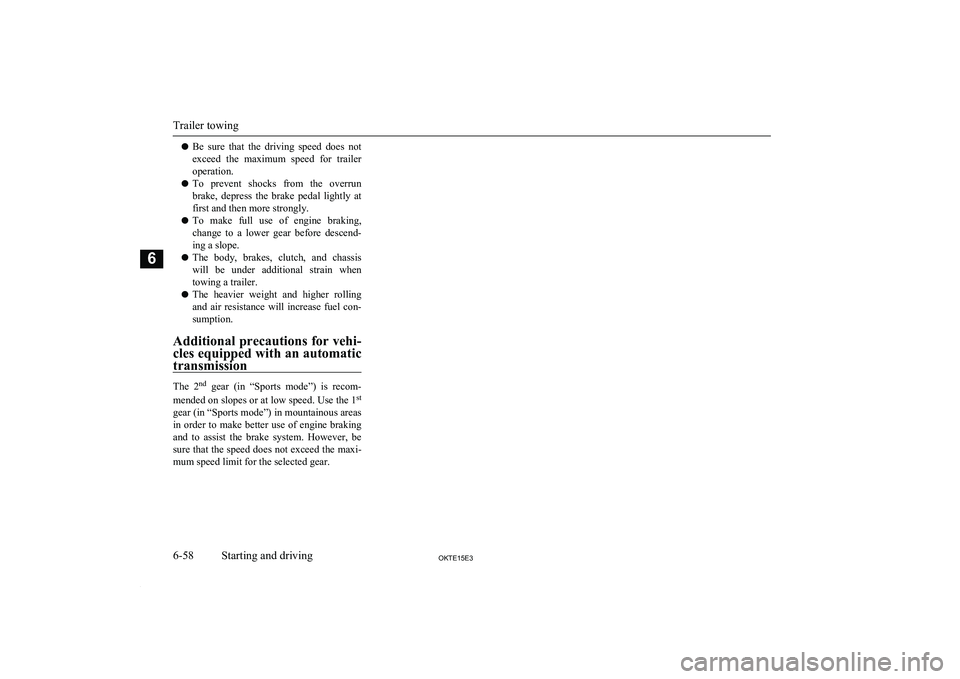
lBe sure that the driving speed does not
exceed the maximum speed for trailer
operation.
l To prevent shocks from the overrun
brake, depress the brake pedal lightly at first and then more strongly.
l To make full use of engine braking,
change to a lower gear before descend-
ing a slope.
l The body, brakes, clutch, and chassis
will be under additional strain when
towing a trailer.
l The heavier weight and higher rolling
and air resistance will increase fuel con- sumption.
Additional precautions for vehi-
cles equipped with an automatic
transmission
The 2 nd
gear (in “Sports mode”) is recom-
mended on slopes or at low speed. Use the 1 st
gear (in “Sports mode”) in mountainous areas
in order to make better use of engine braking and to assist the brake system. However, be
sure that the speed does not exceed the maxi- mum speed limit for the selected gear.
Trailer towing
6-58OKTE15E3Starting and driving6